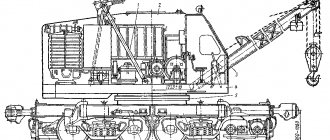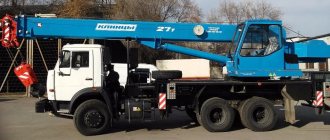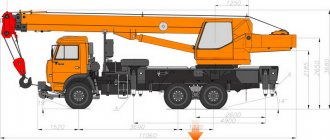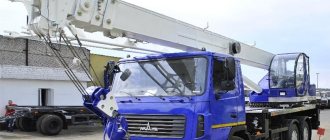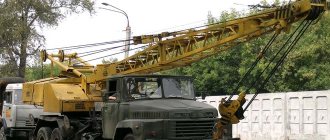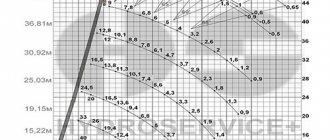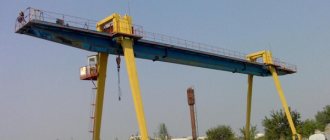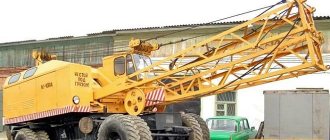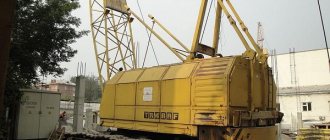Description and technical characteristics of OPU-6 (17-03000B)
OPU 17-03000B with a diameter of 2.24 m is a large bearing
, on the inner ring of which there is a ring gear (internal gear OPU).
The rotary support solves two important problems
.
Firstly, it provides the crane with a 360-degree working area
, thanks to the ability to rotate the working platform around a vertical axis.
Secondly, it is through the overhead support that part of the loads that arise during the transfer of goods is redistributed from the rotating platform to the crane running gear
(in this case, to the railway platform) or to the outriggers. Without this device, the crane's lifting capacity would be significantly less.
Since OPU-17-03000B experience significant loads, they are made of special heat-resistant steel
.
Special requirements are imposed not only on strength, but also on the integrity of the product. For example, if there is even the slightest crack on the ring gear, then the ring needs to be replaced
. If you do not replace it in time, the rotary support will fail and the crane will simply stop.
OPU-17-03000B can be repaired if the problem does not concern the ring gear. For example, you can change seals, replace rolling elements, or machine grooves for rollers (balls). To do this, you need to remove the rotary support and disassemble it
Please note that it is better to carry out the above operations under the supervision of specialists, and if grooving is required, then not only an accurate calculation is required, but also special equipment.
Kzhde railway crane in Ukraine
Price not specified
PTO Komplekt, LLC, Kyiv
Cranes
railway boom KZhDE
-16,
KZhDE
-25 spare parts.
Price not specified
Crane for rent
on
the
KZhDE
railway from the machine-building plant... Load capacity 16 tons.
Crane
weight - 54.6 tons
ZAZ, ChAO, Zaporozhye
Tap
1990 release.
Not ... the load magnet on the crane
, breaks in the current supply cables from ... the source to the
crane's
, corrosive wear and destruction of ... metal hoses
Price not specified
Adonis Techno, LLC, Kremenchug
Slewing gearbox for railway
cranes
KDE-163, KDE-253,
KZhDE
-16,
KZhDE
-25, after
Price not specified
Tekhnoprom, LLC, Dnepr
Sale, purchase, maintenance of spare parts for railway
cranes
of the brands KZh, KZhDE, takraf,
KZhDE KDE
cranes urgent purchase 200,000 hryvnia
Promtekhkomplekt, LLC, Kremenchug
long term own railway
crane
KZh561 (modification after
KZhDE
25) 1994
Lokomotiv Diesel Service, LLC, Zaporozhye
overhaul (CR) of railway
cranes
KDE,
KZhDE
, KZh, EDK.
... railway cranes
are carried out according to the technical specifications: “
Diesel-electric
railway
crane Selling a crane
on
the
KZhDE
railway from the machine-building plant... Load capacity 16 tons.
Crane
weight - 54.6 tons All
Price not specified
Donetsk Institute of Problems..., ChAO, Kramatorsk
-Bridge -Gantry -Tower -Automobile - Railway
-Car lifts Pressure vessels... booms -production of booms for
railway cranes
-non-destructive laboratory
Price not specified
PPZhT, LLC, RU Kyiv, UA
We sell
railway
cranes EDK 1000/2, EDK....
sub-firing platform with counterweights. Cranes
have a multi-purpose purpose: for
Price not specified
Shvab I.V., sole proprietor, Kramatorsk
I will sell a starter for a railway
crane
. Price is negotiable. New. see photo
Dizelprom, private enterprise, Zaporozhye
Conversion of railway cranes
KZhDE
-16 to diesel engines YaMZ-236, YaMZ-238, instead of diesel K-661
Price not specified
PromSnab, LLC, Kyiv
Railway
crane No. 326
Price not specified
Kaltair, private enterprise, Nikolaev
The KZhDE
crane is in excellent working condition….
Load capacity 16 tons. The crane
weight is 54.6 tons. All
Price not specified
Euromash, ChP, Kyiv
Spare parts for railway cranes
KZhDE
KD
KZhDE
-16.25t. kd-163. kd-253.
Kraft, LLC, Odessa
Selling railway
rotary
crane
EDK 80/2, year... gauge 1524 mm.
Crane
weight 58 tons. Price negotiable
Tekhnotranstrade, private enterprise, Kalush
For tap
KDE-163 and
KZDE
-16
DZMU, ChAO, Kamenskoye (Ukr)
Railway
crane
(Takraf) EDK-300, Dismantled... expediently, for spare parts.
Crane
weight 100 tons. Selling.
Osadchiy, private enterprise, Kramatorsk
Railway
jib diesel-electric full-rotate
crane
with a lifting capacity of 25 tons, year of manufacture 1984, working condition.
StroyTsentr, LLC, Kyiv
Railway
crane
EDK-300/2 ... eliminating the consequences of rolling stock derailments
,
as well as ... 70.8 t
Crane
- 84 tons Also available ... tower
cranes
KB403, KB405,
Price not specified
Donetsk Institute of Problems..., ChAO, Kramatorsk
Technologies" will produce booms for railway
cranes
. Booms - angular - tubular - telescopic
Price not specified
PPZhT, LLC, RU Kyiv, UA
Railway
crane KZh-561 (25 tons) ... laying other communications along
the railway
track.
The railway crane
can be transported (without
Adonis Techno, LLC, Kremenchug
unit repair of cranes
KDE-163, KDE-253,
KZDE
-16,
KZDE
-25
Price not specified
Euromash, ChP, Kyiv
Running trolleys of the railway crane
KZhDE
-25 87g. pantograph rotation gearbox
Price not specified
Donetsk Institute of Problems..., ChAO, Kramatorsk
Technologies" will produce booms for railway
cranes
. Booms - angular - tubular - telescopic
Price not specified
Adonis Techno, LLC, Kremenchug
Tap block
KDE-163, KDE-253,
KZhDE
-16,
KZhDE
Railway crane KDE-161 with a lifting capacity of 16 tons, diesel-electric, self-propelled, full-rotary, designed for construction and installation, as well as loading and unloading work with piece and bulk cargo. In the basic version, it is manufactured with a straight lattice boom 15 m long and a hook cage. Upon request, the crane can be equipped with a grab for bulk materials, a grab for loading timber, a lifting electromagnet, an L-shaped 15-meter boom for cargo of significant dimensions, as well as an insert for a straight boom that extends it to 20 m. The crane has multi-engine diesel-electric drive, which allows for independent movements of individual crane mechanisms, as well as combination of operations. The crane is powered by a voltage of 380 V. The crane is equipped with automatic normally closed shoe brakes with electro-hydraulic pushers, load lifting height limiters, and can also be powered directly from an external AC power supply for boom outreach and lifting capacity. The crane consists of a rotating and running parts, interconnected by a slewing support, and boom equipment. The rotating platform serves as the base on which all the crane mechanisms are mounted (except for the movement mechanism), as well as the portal, boom and body with the control cabin. The crane mechanisms, including the power unit, located on the turntable, are mounted on individual frames that are attached to the platform. The crane operator's cabin with control panel, located in front of the turntable, has good visibility and is isolated from the machine room. The slewing bearing is a double-row ball bearing with an internal gear ring. The rotation mechanism of the turntable consists of an 11 kW electric motor, a bevel-helical gearbox and a shoe brake with an electro-hydraulic pusher. The double-drum load lifting winch consists of two two-stage gearboxes with cylindrical helical wheels mounted in one housing, two 22 kW electric motors and two shoe brakes with electro-hydraulic pushers. The presence of individual winch drum drives allows you to work with each drum separately or with two at once, which expands the range of lifting speeds, and also makes it possible to work with a two-rope grab. The single-drum type boom winch has an individual 14 kW motor. The DG-75-3 type power plant consists of a K-661 diesel engine and an ECC5-93-4-M101 generator, connected to each other by a flexible coupling. The crane's running platform consists of a welded frame with ballast, mounted on two carriages and equipped with automatic brakes and harnesses. The trolley is equipped with identical movement mechanisms, each consisting of a 22 kW electric motor, a three-stage spur gearbox, a coupling connecting the electric motor to the gearbox and a permanently closed shoe-type brake with electro-hydraulic pushers. During long stops and parking, the crane is slowed down by a hand brake shoe mounted on the frame of the crane chassis. Railway crane KDE-251 with a lifting capacity of 25 tons, diesel-electric, self-propelled, full-rotary, designed for loading and unloading operations with piece and bulk cargo and installation and construction work.
It is equipped with four types of interchangeable equipment: a load hook, a bulk material grab, a timber grab and a load electromagnet. The length of a normal lattice boom is 15 m. For construction and installation work, an extended boom with a length of 20 and 25 m can be used. The latter can be equipped with a five-meter jib with an additional hook clip with a lifting capacity of 7.5 t. The crane has a multi-engine diesel-electric drive. In terms of its design and the units and components used, it is highly (approx. 80%) unified with the KDE-161 crane: travel mechanisms, folding outriggers, parking brakes, trolleys, power unit, slewing bearing, slewing mechanism, main and boom winches, etc.
Block 33-100000-001-01 cast iron
The valve blocks use bearings with protective washers filled with lubricant. Replenishment with lubricant during operation is not required.
Important PSU and power steering KamAZ: how to pump, device, adjustment
To protect the rope from rusting, as well as to avoid premature wear and rubbing of individual wires against each other and on the surface of the blocks, the rope must be regularly lubricated with rope lubricant. A mixture of 90% grease and 10% bitumen can also be used as a rope lubricant. When lubricating, the mixture must be heated to 60 °C. The approximate rate of lubricant for lubricating a rope is 3 g per meter of length and millimeter of diameter. The brakes should be lubricated at least once a month. In winter it is necessary to use winter grades of lubricant, in summer - summer grades. Deviation from this rule will lead to disruption of the mechanism’s operating mode.
Railway cranes KDE-161, KDE-163, KDE-253, KDE-251
have a similar design, which consists of several components.
For example, a rotary platform includes a boom, an A-frame, and an operator's station. This also includes the slewing ring, work equipment and trolleys. It is worth knowing that block 24-10030-20
is located in the portal of a railway crane and allows you to simplify the operation of boom equipment.
Technical characteristics of the KDE-163 railway crane and other modifications
Model KDE-163 belongs to a series of railway cranes equipped with a diesel-electric drive. The machines are supplied with booms of various lengths and configurations and are used to move piece goods. It is possible to use grab grips for loading tree trunks, as well as magnetic units that allow you to reload rolled steel waste.
Basic technical data of jib cranes
By the nature of work on railway transport, rail-mounted cranes are the most common, although crawler-mounted and pneumatic cranes are also used. Cranes consist of two main parts: a running platform and a lifting and slewing frame with a boom and load-handling devices. The rotating frame also houses the power unit, the main operating mechanisms of the crane, a boom with load-handling devices and controls.
Each self-propelled full-rotating jib crane has at least four mechanisms: lifting the load, changing the boom reach, rotating the top of the crane, and a mechanism for moving the crane self-propelled. All ethn mechanisms can be driven from individual drives or in combination from one power drive.
In Fig. 1, 2 show full-rotating jib cranes, rail-mounted cranes with a lifting capacity of 15, 16 tons.
The technical characteristics of the crane are the lifting capacity, the power of the power drive and the total power of the installed engines, the speed of lifting the load and moving the crane self-propelled, the time of complete change of the boom radius, the rotational speed of the rotating frame of the crane, the maximum lifting height of the load-handling device, the radius described by the rotating part of the crane, overall dimensions , weight of the crane and permissible speed of transportation of the crane as part of the train.
The power of thermal engines (steam, internal combustion engines) is expressed in horsepower (hp), and electric in kilowatts (kW).
The speed of lifting cargo and self-propelled movement is expressed in meters per 1 minute (m/min), and the speed of transporting a crane as part of a train is expressed in kilometers per 1 hour (km/h).
The time it takes to raise or lower the crane boom from one extreme position to the other is expressed in minutes (min).
The speed of rotation of the crane's upper frame is characterized by the rotation speed.
The boom reach is the horizontal distance between the axis of rotation of the crane and the vertical line passing through the load suspension point.
The size of the area served by the crane depends on the reach of the boom: the greater the reach, the larger this area; but as the reach increases, the possibility of the crane overturning increases, as its stability decreases; therefore, as the reach increases, the weight of the load being lifted must be reduced. For increased stability and the ability to lift heavier loads
Rice. 1. Diesel-electric crane KDE-161 with a lifting capacity of 16 tons:
1 — crane portal; 2-crane body; 3 - cargo boom; 4 — rotating part of the crane; 5 — rotating support; 6 — diesel generator set; 7 — muffler; 8 — boom lifting mechanism; 9 — cable holder; 10 — control station; 11 — running trolley; 13 — lower running frame; 13 — cargo winch; 14 — outrigger; 15 — movement mechanism; 16 — fuel tank; 17 — rotation mechanism; 18 — driver’s seat; 19 — control panel
/ — cargo drum shaft; 2 - main shaft; 3 — vertical drive shaft of wheelsets; 4- horizontal shaft of the boom lifting mechanism; 5 — horizontal rotation shaft; 6 — vertical shaft of the boom lifting mechanism; 7 - main valve; 8 - steam regulator; 9 — boom drum axis; 10 — boom lift drum; //- vnlka; 12 — traverse; 13 — cargo drums; 14 - load capacity indicator; 15-upper support ring; 16 — support rollers; 17- lower support ring; 18-nut of the central kingpin; 19 — central kingpin; 20 — vertical rotation shaft; 21 — horizontal wheel pair drive shaft; 22 — cam clutch; 23 — manual drive of the trolley brake; 24 — rotation clutches; 25 — rotation brake; 26 — load clutches; 27 — load brakes; 28 — wheel pair drive clutches; 29 — wheel drive brake; 30 — trolley air brake drive; 31 — outrigger; I - worm; And — gear of the boom lifting mechanism; III - crown of rotation; IV - cylindrical gear of the vertical rotation shaft; V - cylindrical gear of the horizontal wheel pair drive shaft; VI - lower bevel gear of the vertical wheel pair drive shaft; VII - bevel gear of the horizontal wheel pair drive shaft; VIII - split spur gear; IX — cylindrical gear of the cargo drum shaft; X - spur gear of the main shaft; XI - intermediate gear; XII - left cylindrical gear of the horizontal shaft of the boom lifting mechanism; XIII - bevel gear of the horizontal shaft of the boom lifting mechanism; XIV - bevel gear of the horizontal rotation shaft; XV - bevel gear of the horizontal rotation shaft; XVII — right cylindrical gear of the horizontal shaft of the boom lifting mechanism; XVIII—
Railway crane KDE-163: 253, 251, 161 technical characteristics, models
The KDE-161 railway crane with a lifting capacity of 16 tons is a diesel-electric, self-propelled, full-rotating crane, designed for construction and installation, as well as loading and unloading work with piece and bulk cargo. In the basic version, it is manufactured with a straight lattice boom 15 m long and a hook cage. Upon request, the crane can be equipped with a grab for bulk materials, a grab for loading timber, a lifting electromagnet, an L-shaped 15-meter boom for cargo of significant dimensions, as well as an insert for a straight boom that extends it to 20 m. The crane has multi-engine diesel-electric drive, which allows for independent movements of individual crane mechanisms, as well as combination of operations. The crane is powered by a voltage of 380 V. The crane is equipped with automatic normally closed shoe brakes with electro-hydraulic pushers, load lifting height limiters, and can also be powered directly from an external AC power supply for boom outreach and lifting capacity. The crane consists of a rotating and running parts, interconnected by a slewing support, and boom equipment. The rotating platform serves as the base on which all the crane mechanisms are mounted (except for the movement mechanism), as well as the portal, boom and body with the control cabin. The crane mechanisms, including the power unit, located on the turntable, are mounted on individual frames that are attached to the platform. The crane operator's cabin with control panel, located in front of the turntable, has good visibility and is isolated from the machine room. The slewing bearing is a double-row ball bearing with an internal gear ring. The rotation mechanism of the turntable consists of an 11 kW electric motor, a bevel-helical gearbox and a shoe brake with an electro-hydraulic pusher. The double-drum load lifting winch consists of two two-stage gearboxes with cylindrical helical wheels mounted in one housing, two 22 kW electric motors and two shoe brakes with electro-hydraulic pushers. The presence of individual winch drum drives allows you to work with each drum separately or with two at once, which expands the range of lifting speeds, and also makes it possible to work with a two-rope grab. The single-drum type boom winch has an individual 14 kW motor. The DG-75-3 type power plant consists of a K-661 diesel engine and an ECC5-93-4-M101 generator, connected to each other by a flexible coupling. The crane's running platform consists of a welded frame with ballast, mounted on two carriages and equipped with automatic brakes and harnesses. The trolley is equipped with identical movement mechanisms, each consisting of a 22 kW electric motor, a three-stage spur gearbox, a coupling connecting the electric motor to the gearbox and a permanently closed shoe-type brake with electro-hydraulic pushers. During long stops and parking, the crane is slowed down by a hand brake shoe mounted on the frame of the crane chassis. The KDE-251 railway crane with a lifting capacity of 25 tons is a diesel-electric, self-propelled, full-rotating crane, designed for loading and unloading work with piece and bulk cargo and installation and construction work.
It is equipped with four types of interchangeable equipment: a load hook, a bulk material grab, a timber grab and a load electromagnet. The length of a normal lattice boom is 15 m. For construction and installation work, an extended boom with a length of 20 and 25 m can be used. The latter can be equipped with a five-meter jib with an additional hook clip with a lifting capacity of 7.5 t. The crane has a multi-engine diesel-electric drive. In terms of its design and the units and components used, it is highly (approx. 80%) unified with the KDE-161 crane: travel mechanisms, folding outriggers, parking brakes, trolleys, power unit, slewing bearing, slewing mechanism, main and boom winches, etc.
How to buy the correct slewing support device OPU 33-030000-000-01 for railway cranes?
It is better to buy or repair the presented equipment from reputable and serious companies that supply only high-quality parts. After all, the operation of the machine will depend on the quality of the slewing bearing
. A low-quality part can cause the faucet to break down, or lead to even worse situations.
Important Characteristics and features of the flagship KamAZ-6580 dump truck
sells both new crane slewing bearings and components from disassembly or after major repairs
. A large assortment and low prices make it possible to select spare parts that meet customer requests in terms of technical condition and cost requirements for parts. We also deliver OPU 33-030000-000-01 for railway cranes to all cities of Russia and the nearest CIS countries.
There are four types of slewing bearings:
with ball circles, with roller circles, with spaced supports such as “bell” or “glass”.
Slewing ring with ball and roller circles
It has a compact design (as it has a low height and free internal space), low weight, high reliability and durability, and ease of maintenance. Therefore, they are currently the most common.
Slewing bearings with single-row roller circles
more efficient, since with small overall dimensions and weight they have, in many cases, greater load-bearing capacity than double-row ball circles. In a single-row roller circle, the rollers are placed crosswise in one common groove.
Single-row rotary roller supports with external and internal teeth
are used as the main base unit in lifting machines and mechanisms (construction towers, excavators, tower, truck, and jib cranes) with a working rotary body with a rotation speed of up to 16 revolutions per minute.
Selection and supply of railway cranes from Russian and foreign manufacturers
with the technical characteristics required for your construction projects.
A team of experienced and professional managers will ensure prompt execution of your orders. We strive to make the process of purchasing and delivering products as simple as possible for you. Therefore, when working with each customer, we undertake not only to provide the enterprise with products, but also to resolve all issues and problems related to supply. Meeting your expectations, we offer the optimal ratio of price and delivery time
.
Application of polyamide
Polyamide is a synthetic substance with anti-friction properties. This gives some advantage over metal counterparts. After all, the main reason for failure of boom equipment elements is wear due to constant friction. In addition, the polyamide pulley block 33-100000-001-01
to reduce noise and vibration levels during crane operation. Due to low moisture absorption, polyamide components have a long service life and are not afraid of temperature changes. Installing such a part will make the operation of special equipment safer and more efficient.
Boom replacement and repair 24-15000
The most common symptoms of crane boom failure are wear on the base axles, breaks in welded joints, and a visually noticeable bend in the boom. To prevent the boom from permanent failure, it is necessary to regularly inspect it, and also to prevent overload and collision with various objects: walls, trees, etc.
Please note that in addition to obvious signs indicating malfunctions, there are also those that are not so easy to find, such as rupture of welded parts. We can send experienced specialists who will carry out a thorough troubleshooting
Block 33-100000-001-01 cast iron
The valve blocks use bearings with protective washers filled with lubricant. Replenishment with lubricant during operation is not required.
To protect the rope from rusting, as well as to avoid premature wear and rubbing of individual wires against each other and on the surface of the blocks, the rope must be regularly lubricated with rope lubricant. A mixture of 90% grease and 10% bitumen can also be used as a rope lubricant. When lubricating, the mixture must be heated to 60 °C. The approximate rate of lubricant for lubricating a rope is 3 g per meter of length and millimeter of diameter. The brakes should be lubricated at least once a month. In winter it is necessary to use winter grades of lubricant, in summer - summer grades. Deviation from this rule will lead to disruption of the mechanism’s operating mode.
Polyamide block
Installation of block 4-15040-08 for railway cranes KDE-163, KDE-253
is carried out between the boom segments. During operation, metal elements are subject to negative effects and quickly fail. Installing the polyamide block 4-15040-08 allows us to minimize this impact. After all, polyamide has anti-friction properties, high strength and reliability. The presence of such elements makes the operation of the lifting mechanism efficient and safe.
Advantages of polyamide
- durability
- reliability
- frost resistance
- low moisture absorption
- unacceptability
- availability
Railway crane KDE-163: 253, 251, 161 technical characteristics, models
§ 34. ELECTRICAL DIAGRAMS OF RAILWAY CRANES
Schematic electrical diagram of diesel-electric railway cranes KDE-163 and KDE-253
In Fig. Figure 64 shows a schematic electrical diagram of the diesel-electric cranes KDE-163 and KDE-253, which is the most complete for the KDE series cranes. Using this diagram, we will follow the implementation of the main operations of the cranes. Conventional graphic symbols for the electrical circuit are given in table. 16a.
Once the diesel engine is started and its stability and operating mode are established, the G1 generator will begin to generate three-phase alternating current and a normal voltage of 380-400 V will be established at its terminals.
By manually turning on the three-pole linear switch B7 to the power position from the generator, current is supplied to the power and auxiliary (control, lighting, alarm) lines. In this case, all auxiliary lines and power lines of the cargo electromagnet are turned on directly through the switch, while all others (power lines) are additionally turned on through the linear contactor P12. This was done in order to ensure the possibility of controlling the crane and safe operation of the load magnet, since even if the linear contactor is turned off and the power lines are de-energized, the load electromagnet remains energized and will not release the taken load. Turn on the linear contactor with the Kn9 start button; At the same time, for safety reasons, the so-called zero blocking is implemented, which allows the linear contactor to be turned on and current supplied to the power lines only if all controllers and command controllers are in zero positions, i.e. in the non-working position, and the door to the machine room compartment is securely closed.
Purchase of railway cranes KDE-163
Our company sells and buys KDE-163 railway cranes.
We mainly purchase heavy special equipment (cranes, bulldozers, graders, etc.) for restoration and sale. In addition, we can buy a used KDE-163 railway crane or other machine for use as a donor, that is, for disassembly for spare parts
Why is it more profitable today to buy used KDE-163 railway cranes?
A new crane, railway or other, is expensive, an imported one is very expensive. All modern Russian cranes and other special equipment contain imported parts, which are now also expensive and will not become cheaper. And the KDE family cranes, firstly, are much cheaper, and secondly, they are easier to maintain and repair. At the same time, the safety factor invested by designers in Soviet railway cranes allows them to be used for decades. Practice shows that with proper handling and regular maintenance, KDE railway cranes can operate for 30-50 years or more. That is why the purchase of a KDE-163 railway crane is quite a profitable purchase not only for small enterprises, but also for large companies.
Important All-terrain manipulators based on KamAZ 6x6 with a bunch of additional equipment
When purchasing used railway cranes KDE-163 or other models, you may encounter the problem of finding spare parts that have long been discontinued.
In this case, there are 2 options:
- purchase of KDE-163 railway cranes
or other equipment for subsequent disassembly into parts; - purchasing
scarce parts from companies specializing in piece orders of no longer produced parts.
In the first case, you can spend a lot of money, and the parts will not be in very good condition, but in the second, you can spend a lot of time and not find a reliable manufacturer. In order not to waste time and not run into scammers, it is better to seek help from. We have many partners who carry out individual orders and we can guarantee that they approach the work responsibly and perform it efficiently.
Kranmaster LLC is a dealer of thirty manufacturers of special equipment, therefore, if you decide to buy KDE-163 Railway cranes
at a low price, contact our company.
We deliver special equipment to the regions.
We carry out priority shipments to the following cities: Anadyr, Arkhangelsk, Astrakhan, Barnaul, Belgorod, Blagoveshchensk, Bryansk, Vladivostok, Vladimir, Volgograd, Vologda, Vorkuta, Voronezh, Gorno-Altaisk, Yekaterinburg, Ivanovo, Izhevsk, Irkutsk, Yoshkar-Ola, Kazan , Kaliningrad, Kaluga, Kemerovo, Kirov, Kostroma, Krasnodar, Krasnoyarsk, Kurgan, Kursk, Kyzyl, Labytnangi, Lipetsk, Magadan, Moscow, Murmansk, Naryan-Mar, Nizhny-Novgorod, Novgorod, Novosibirsk, Omsk, Orel, Orenburg, Penza , Perm, Petropavlovsk-Kamchatsky, Pskov, Rostov-on-Don, Ryazan, Salekhard, Samara, St. Petersburg, St. Petersburg, Saransk, Saratov, Smolensk, Stavropol, Surgut, Syktyvkar, Tambov, Tver, Tomsk, Tula, Tyumen , Ulan-Ude, Ulyanovsk, Ufa, Khabarovsk, Khanty-Mansiysk, Cheboksary, Chita, Yuzhno-Sakhalinsk, Yakutsk, Yaroslavl.
| Characteristics of the KDE-163 railway crane | |
| Load capacity (on outriggers) | 16 t |
| Load capacity (without supports) | 8 t |
| Hook lift height (max) | 13.6 m |
| Load lifting speed (2 drums) | 17.8 m/min |
| Load lifting speed (1 drum) | 8.9 m/min |
| Crane weight (in operating condition) | 55 t |
| Maximum wind speed at which operation is allowed | 18 m/sec |
| Speed of a special train | up to 100 km/h |
The cargo is delivered by a transport company to the terminal in your city
The carrier contacts you and informs you about the arrival of the cargo
With a power of attorney from the organization or with a passport (if the cargo is sent to a private person), you can receive the goods
Payment is made upon receipt in cash or by bank transfer
Cost calculation can be done on the websites
Transport companies:
Courier companies:
We provide post-warranty service for equipment purchased from us with a visit to your site in a short time.
Models
All models of KDE series cranes were produced by a machine-building plant located in Leningrad (now St. Petersburg). The equipment has been mass-produced since the late 60s and has a load capacity of 16-25 tons.
The machine is based on a steel frame welded from a large number of longitudinal spars and transverse beams. Ballast weight and additional equipment are placed in the free space. The end parts are equipped with railway automatic couplers designed for transporting the unit as part of a train.
The chassis consists of 2 paired bogies with spring shock absorption. The trolleys are equipped with traction motors with multi-stage gearboxes, which can be switched while the crane is stationary. The energy source is a diesel generator located on the rotating part of the machine. The transmission of electric current is carried out through slip rings installed in the rotary chase.
The braking system includes standard trolley mechanisms that press the pads against the outer running surface of the wheels. When moving in a hitch, the brakes are connected to a common network; they are controlled by the train driver. Additionally, a mechanical drive of the blocks is installed, which is used when the crane unit is parked.
KDE-163
The KDE-163 railway crane is designed for loading materials and parts weighing up to 16 tons. The basic model was supplied with a 15 m boom and a hook grip. On a separate order, the plant equipped the machine with additional lifting devices and a boom extension insert 5 m long. When using an extension, it is allowed to move loads only with a hook.
The diesel generator DG 75-3 is located on the turntable. The installation is equipped with a forced liquid cooling system. To ensure temperature conditions during long-term operation, an oil cooling system is used. The radiators are installed in 1 block, blown by a multi-bladed fan with a mechanical drive. The standard equipment includes an electrical cable for connecting to an external power source.
Technical characteristics and dimensions:
- trolley base - 1850 mm;
- the distance between the centers of the trolleys is 2950 mm;
- hitch height - 1040 mm;
- installation length (excluding boom reach and couplings) - 7016 mm;
- width - 3120 mm;
- hook lifting height - 13.7-18.5 m;
- transportation speed - up to 80 km/h;
- weight - 63.93 tons.
KDE-253
The KDE-253 crane with a lifting capacity of 25 tons is built on the basis of components of the previous model. The difference is the increased size of the running platform and the reinforced design of the boom equipment. The electrical circuit and energy sources remain unchanged.
Description of crane parameters:
- load lifting speed - 5.3-17.8 m/min;
- the time required to raise the boom to the maximum is 55-60 seconds;
- platform rotation speed (smoothly adjustable) - 0-1.5 rpm;
- self-propelled speed – up to 8 km/h;
- curb weight - 66.41-67.18 tons.
KDE-251
The KDE-251 crane, as standard, has a lattice boom 15 m long, designed to move a load weighing 25 tons. The boom has a detachable design, allowing the installation of additional sections that increase the length of the unit to 20 or 25 m. When using a boom of maximum length, a jib is installed, having a size of 5 m. In this case, the machine is equipped with a hook cage designed for a load of up to 7.5 tons.
The cranes are equipped with a diesel unit DG 75-3, developing a power of 115 hp. The design of the unit includes an alternating current generator. Asynchronous motors with a power of 3.5 to 30 kW are mounted in the chassis design and on the lifting winches.
Crane characteristics (when installing a 15 m long boom and working on supports):
- boom radius - 4.5-14.0 m;
- load capacity range - 5-25 t;
- hook lifting height - 9.0-13.5 m;
- load lifting speed - up to 12.5 m/min;
- rotation speed of the moving platform - up to 2 rpm;
- travel speed - up to 25 km/h;
- installation weight - 69 t;
- base - 4000 mm;
- track width - 1524 mm.
KDE-161
The KDE-161 crane is designed for moving piece goods weighing up to 16 tons. The power plant includes a 6-cylinder diesel engine K-661, equipped with a mechanical supercharger. The motor is equipped with a special coupling that transmits torque to the rotor of a 3-phase ECC5-93 generator.
